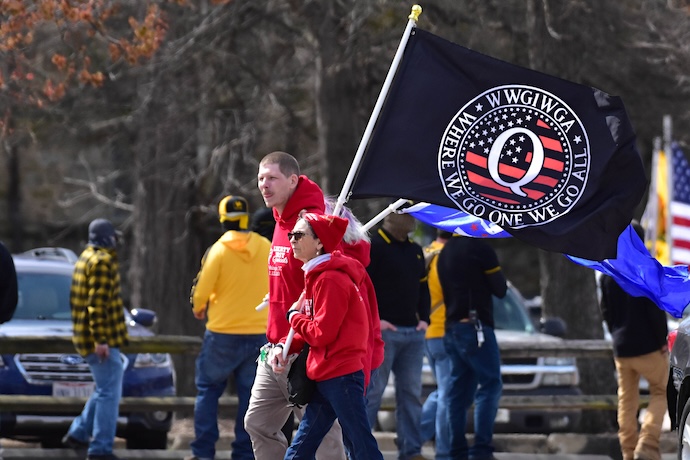The outlines of QAnon conspiracy theories are by now familiar to many. The battle of good-versus-evil personified by Donald Trump and the Deep State, which somehow also embroils bizarre and gruesome allegations of child trafficking, drinking adrenaline compounds to get high, the ever-imminent arrest of Hillary Clinton, and aliens. What may be less well-known is the impact of QAnon on American families, which is Jesselyn Cook’s premise in The Quiet Damage: QAnon and the Destruction of the American Family. Through carefully researched individual narratives, Cook tells the story of people who got into QAnon and then rejected—or were rejected by—family members, and the grief and damage that ensues from these domestic ruptures.

The Quiet Damage: QAnon and the Destruction of the American Family
Jesselyn Cook
Crown
July 23, 2024
It’s hard going to read compounding tales of people ruining their marriages and relationships with their children; losing their friends; getting ostracized from their communities; turning family members against each other; traumatizing their young children; making their adult children suicidal; getting sick from taking inappropriate medications or leaving ailments untreated; and even getting committed to psychiatric wards. Cook shows how many Americans have been affected, from all walks of life, men and women, Black and White, young and old. What united these seemingly normal yet disparate people was that they liked how QAnon made them feel.
By laying bare the emotional manipulation of conspiracy theories, these stories show how such theories can make you agitated and upset before delivering you from the hole they put you in by providing an answer—a way out to something better. For some, this fight of good versus evil becomes an emotional crutch for their deep-seated unresolved traumas. They connect with something larger than themselves, swallowing them up in a bigger fight, making them feel important, and filling their lives with meaning. But this is also the problem, as Cook shows. While the threat to democracy QAnon represents has been much debated, especially since the Capitol Siege on Jan 6, 2021, what Quiet Damage reveals is the quotidian underbelly of the same problem. Political violence and domestic violence are two sides of the same coin.
A Better World Awaits
Focusing on five families, Cook divides the narratives by chapter, each of which begins with a family name. Some center the perspective of QAnon adherents themselves, while others feature the perspective of close family members. In both cases Cook aims to humanize them and restore their dignity. By paying close attention to the journey, these family-based narratives describe how one member got to the point where QAnon actually begins to make sense. The importance of social relationships and trust in building believability is emphasized—how people hear from it via friends or influencers online that they already trust.
The core message of QAnon is something that many people already believe: that those in power are corrupt. As such, the wilder-sounding theories confirm things they already believed on some level—that elites have rigged the system in their own favor, shutting out everyone else, trapping them in debt, and that innocents suffer as a result. The media divide people to distract from this elite control, while the rich get richer and everyone else is held back.
By affirming these generalized and unfalsifiable beliefs, QAnon offers a better world, a chance to fight for righteousness and freedom. It does so by offering easy and certain answers in a time of uncertainty and fear by identifying villains to unite against and providing a sense of purpose and meaning—a mission even. People with humdrum lives can instead feel like digital soldiers fighting a war to save America.
Why Does Q Take One Person But Not Another?
While the aim to humanize those who engage with conspiracy theories is laudable and welcome, the treatment of why some resonate with those theories—while others in similar circumstances do not—retreads familiar ground. Conspiracy theories are, once again, “an intangible poison infecting many millions of minds.” The contagion metaphor of conspiracy theories is a framing so familiar in the study of radically different beliefs that it is, by this point, almost hackneyed.
In repeating commonplace metaphors of conspiracy theories as brainwashing, something that, “took her mind,” as Cook writes of one QAnon adherent, little is added to help understand the particularity of conspiracy theories. Why, when there are two sisters raised together in the same social and material conditions, does one accept QAnon and the other does not? You won’t find that answer in this book.
Instead, Cook makes it seem like it can happen to anyone who happens to be infected, like a disease. An overreliance on shallow psychological analyses decontextualizes conspiracy theories and the people who believe them. Why do some believe “outlandish falsehoods” in the face of “cold, hard facts,” as Cook describes it? The answers provided in The Quiet Damage all individualize and psychologize the motivation: Loneliness, financial insecurity, health scares.
Those who find QAnon appealing get to see themselves as victims and others as villains in a way that makes sense of their perceived suffering. That’s why it appealed to moms during the Covid pandemic and to evangelical Christians at the end of the Trump presidency. It plays on your sense of how you’ve been wronged. Downplaying race and class, the suggestion seems to be that, because QAnon appeals across demographics to a sense of powerlessness, anyone can be pulled in.
QAnon creates this appeal by posing questions as much as providing answers. The role of speculation is important, as people enjoy guessing, following the crumbs, making their own theories, and playing the game. Through this intellectual work, they get to become part of a movement. They become part of something larger than themselves. Cook, predictably, calls this process radicalization, replete with the expected rabbit hole metaphors.
Social media Feeds Q… But Q also Feeds Social Media
And, while adherents learn to believe that whatever the mainstream media says is false, Cook does importantly point out that not all of their grievances are illegitimate. Some are quite real, such as endemic anti-Black racism, which meant that Black people were targeted specifically and aggressively by disinformation actors. Cook argues that, as a result of this direct targeting, Black and Hispanic Americans were statistically more likely to believe in QAnon even though it was rooted in White supremacist and antisemitic tropes. Other catalysts similarly come from pre-existing beliefs, but what comes through most clearly is the importance of faith in those who learn to trust the plan of QAnon. It appeals to people who already had religious faith, especially Christians and New Agers, and there’s of course a clear structural resemblance between QAnon’s millenarian Storm and Christian eschatology. While noted, Quiet Damage unfortunately doesn’t do a great job of tying the threads of these wider social contexts together.
What is emphasized is the amplification effect of social media. The narratives start when a friend or relative sends a link to watch a video by QAnon influencers (such as Joe M, Stella Immanuel, or Praying Medic), and then YouTube’s autoplay shows another and then another. Facebook algorithms take people from FarmVille to Breitbart; from a mistrust of doctors to a private group on medical misinformation; from a frustrated Bernie Sanders supporter to the ‘Plandemic’ video. The digital infrastructure of social media platforms creates, as Cook puts it, “a conveyor belt of disinformation.”
Fox News also proves to be a potential breeding ground for aggrievement, which then takes wilder and wilder turns to reach QAnon. But the primary culprits are inevitably Facebook, YouTube, and other social media platforms, where, Cook writes, “[families felt their] shared reality began to fracture.” The vulnerability of old people and young children to social media features clearly, as those populations often don’t have the resilience or awareness to engage with these firehoses of disinformation critically.
Within this contaminated information ecosystem, the role of influencers is crucial. Users form parasocial relationships with them, and in return they produce nonstop conspiracy content while making money from ads, sponsorships, and monetized posts. Of course they’re not the only ones who profit from this relationship; social media platforms also make vast sums from conspiracy theories.
The increased online activity during the Covid pandemic in a feedback loop with the stress and social isolation made people more vulnerable and the platforms richer still. Unrest and uncertainty fuels conspiracy theories which are then given more reach by social media. Yet banning and removing videos is simply taken as confirmation—evidence that they were removed for speaking the truth. It’s clear from the stories in The Quiet Damage that the corporations that run social media platforms are failing their users and should be held responsible for the content that they host, much as traditional media has long been.
Responsibility and pseudoscience
The last section details how to get people out of QAnon but it becomes clear that it’s much more common for people to get themselves out. The story of a son trying to amateur “deprogram” his mom demonstrates, in heart-rending detail, the failure of debunking, and points to the gap between reality and QAnon claims that, for example, Trump won the 2020 election. Human connection proves to be more effective than fact checking in the stories of those relatives who are able to be there for their QAnon-following family members without confirming their beliefs and, when appropriate, gently encouraging them to question them. These are the most difficult but also more successful strategies attempted by the families described.
Their stories also show baffling variability, with some absorbing Trump’s election loss or seeing people they know personally get severely ill from Covid-19 and start to change—but others will not. What comes across most strongly is how difficult it is to help; how even trying can pull you down instead. The moments where family members lose friends or fail exams because of their QAnon-afflicted spouse or parent are some of the most affecting. Getting out is a matter of the person wanting to change. They have to be ready to accept that they might be wrong and to take real accountability and make amends with their loved ones. The book’s conclusion flatly confirms that some will not change, and loved ones must let them go, grieve, and move on without them if they can.
As a journalist, Cook wrote an article about families affected by QAnon and got many more emails in response, which became the genesis of this book. It’s based on “hundreds of hours” of interviews in person, by phone, and online over three years. The pacing is fine, and by chapter 10 it becomes truly heartbreaking. Reading about people ruining their lives and the lives of their loved ones, over and again, is not a light read. In that sense it resembles an addiction memoir.
This resemblance is made explicit in the afterword in which Cook argues that underneath the disinformation crisis is a wellness crisis. Mental health is the real problem, and conspiracy theories are a coping mechanism, cheaper and seemingly less harmful than drugs or alcohol. In dark times like these some will succumb to a mass delusion. Cook’s framing is understandable, but it would have benefitted from more engagement with the work in religious studies on new religious movements, or “cults,” which has analyzed the coexistence of radically different worldviews for decades now, including the impact on families.
As a journalistic rather than academic account, when references to research do appear, they tend to be superficial. Many of the references to academic literature are old, out of date, and contested within their own fields, such as the work of Abraham Maslow, Victor Frankl, and Gustave le Bon (which is from 1895). The references, which tend to favor psychology and media studies, therefore don’t help to make sense of these stories.
It would have been interesting to think about who gets to claim they weren’t responsible because of “brainwashing” and who does not, or which groups and ideas get accused of this and which do not. The Quiet Damage fails to consider such nuances, choosing instead to retread outdated anti-cult literature without actually referencing it (at least until the last two pages of the afterword when a former Unification Church member is quoted). Literature from religious studies on new religious movements, like Catherine Wessinger’s critique of the problematic “cult” label, would have provided valuable perspective, especially given all the references to pseudoscientific terms like “deprogramming” or “brainwashing.”
Alongside the thin use of research, some of the early sections in particular tend to read like Americana fanfic or a generic Hallmark movie script. To take just one example, in the prologue Cook describes QAnon adherents as: “torn apart at the seams—real people consumed by fake news trying to find a way back to each other, and to themselves.” And the subjects’ highly-idealized pre-QAnon lives make the reader feel as though they’re being whacked over the head with the message that they’re just like you! They were living the American dream! Ultimately, Cook gives the impression that, when bad things happen that make you vulnerable, and misinformation fills that void, oops, anyone could end up in QAnon. This formula largely ignores the pre-existing beliefs and material conditions that produce conspiracy theories.
There’s also a bigger question, entirely unaddressed, as to whether people with different beliefs really live in a different reality. It would be weird to suggest that Catholics and Protestants live in alternate realities, but the sensationalized gruesomeness of some of QAnon’s claims continue to provide justification for this assertion. Also, the claim that QAnon’s effect on families hasn’t been as well documented as its effect on democracy or public health seems self-serving. Much of what The Quiet Damage covers is what’s already been said about QAnon. Although the same sort of information is available on the QAnonCasualties subreddit in raw form, what is new and valuable is the close narrative attention devoted to the traumatic and tragic impact of QAnon on five families.





